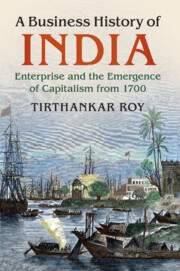Book contents
- A Business History of India
- A Business History of India
- Copyright page
- Dedication
- Contents
- Figures
- Maps
- Tables
- Boxes
- Preface
- 1 Introduction
- 2 The Baseline at 1700
- 3 The Indian Ocean Sphere: 1700–1850
- 4 Capital and Empire (1850–1930)
- 5 Capital and Empire (1850–1930)
- 6 State and Industrialisation: 1930–1950
- 7 State and Industrialisation: 1950–1980
- 8 Revival: 1980–2000
- 9 Capital and Globalisation: 2000–2015
- 10 Conclusion
- References
- Index
5 - Capital and Empire (1850–1930): Industry
Published online by Cambridge University Press: 20 March 2018
- A Business History of India
- A Business History of India
- Copyright page
- Dedication
- Contents
- Figures
- Maps
- Tables
- Boxes
- Preface
- 1 Introduction
- 2 The Baseline at 1700
- 3 The Indian Ocean Sphere: 1700–1850
- 4 Capital and Empire (1850–1930)
- 5 Capital and Empire (1850–1930)
- 6 State and Industrialisation: 1930–1950
- 7 State and Industrialisation: 1950–1980
- 8 Revival: 1980–2000
- 9 Capital and Globalisation: 2000–2015
- 10 Conclusion
- References
- Index
Summary
The trading world that joined the land (agriculture) and the sea (foreign trade) enabled industrialisation in an important, if indirect way. Marketing agents, managers, machines, and engineers needed for a factory to succeed were in short supply in 1850. Agricultural export created the capacity to pay for skilled services and machinery purchased from abroad. Merely the capacity to import machines or hire abroad would not be enough to explain factories. Industry required a great deal more money than did trade, and kept capital locked in for longer. Money was difficult in India. Leveraging would be suicidal for industries in this world, unless the process was carefully planned.
Here, organisation mattered. These resources were procured by different groups by different means. Indians usually operated in the home market, recruited managers from within the extended family, raised investment money from existing businesses, friends, and family. Those people already in longdistance trade had better chance of doing this – another way that agricultural trade helped industrial investment. The Europeans relied more on knowledge of foreign markets and agency networks in these markets. They recruited managers and partners from abroad. Most raised money from London, though increasingly they floated shares in India (mainly Calcutta). Because of these differences, the Europeans were more likely to use the corporate form for their firms, whereas Indians used a hybrid between a family and corporate, adapting the mix depending on their access to capital markets. Both sets of actors relied equally on the recruitment of technical people from abroad.
Because stock markets were undeveloped in India, the London money market did not value Indian investment highly until the railway companies began operation. Banks financed trade and not industrial investment. Industrial firms needed to tap into trading profits. This was true both of Europeans and Indians. But after the Indian Mutiny ended and Crown rule began (1858), a different type of foreign firm entered India. These came to India from an industrial base in Britain, or were fortune hunters with some money who joined industry after a short career in trade. I call them born-industrial, though the term should not be read literally. The British Empire spawned these enterprises in a sense. Faster transportation links, uniform legal framework, and the use of one official language within the Empire encouraged capitalists to become mobile.
- Type
- Chapter
- Information
- A Business History of IndiaEnterprise and the Emergence of Capitalism from 1700, pp. 101 - 125Publisher: Cambridge University PressPrint publication year: 2018



